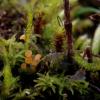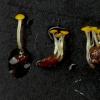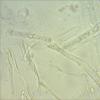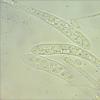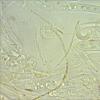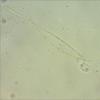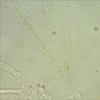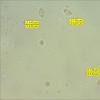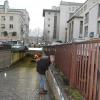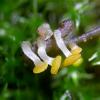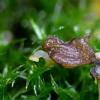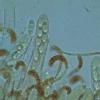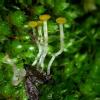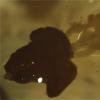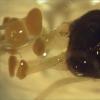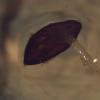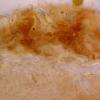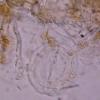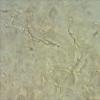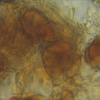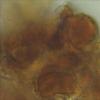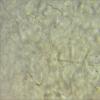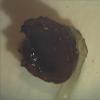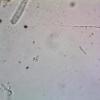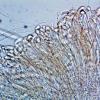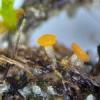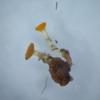
21-12-2025 09:32
Hello.A tiny ascomycete found embedded in wood in

21-12-2025 21:32
Pol DebaenstHello, Garden, Burgweg 19, Veurne, BelgiumOn 10/1

22-12-2025 23:38
Patrice TANCHAUDBonsoir, récolte sur un mur en pierre, apothéci

22-12-2025 00:47
Patrice TANCHAUDBonsoir, récolte à proximité du milieu dunaire

21-12-2025 21:40
Isabelle CharissouBonjour, j'aimerais connaitre les références de

20-12-2025 23:08
Patrice TANCHAUDBonsoir, récolte sur sol sablonneux dans l'arri�
Bright orange asco between mosses in Belgian dune area
William Slosse,
14-11-2020 20:06
 Good evening all,
Good evening all,today 14/11/20 we found the following asco in the Doornpanne (dune area) in Koksijde, Belgium.
The species grew on seeds (including Betula) deep between mosses (Tortula ruralis).
Mushroom height: 4.5mm.
Microscopy in H2O unless stated otherwise.
Asci: J-; 8-spored; croziers present.
Paraphyses: strongly curled; forked; filled with yellow VBs.
Spores: with 2 oil drops; strikingly different in size, even within the asci; 9.55x5.09 (N = 15)
Anyone have an idea?
Regards,
William
Hans-Otto Baral,
14-11-2020 20:26

Re : Bright orange asco between mosses in Belgian dune area
Hi William
exactly the same fungus was collected by Alain Delannoy in Rouen, 7.12.2007. Jean-Paul also got a part of it as I did. The substrate remained unclear.
JPP: the spot where Alain discovered it, no trees no plants only moss acrocarpes and a micro photo of the middle of the support. No hepatic, no lichen, no true sclerote, no algae
Hans-Otto Baral,
14-11-2020 20:28
William Slosse,
14-11-2020 21:21

Re : Bright orange asco between mosses in Belgian dune area
Thx for your information, Hans-Otto.
The substrate must be indeed vegetable.
I surely detected seed of Betula and have it on pictures.
So further no idea concerning the genus of this find?
The substrate must be indeed vegetable.
I surely detected seed of Betula and have it on pictures.
So further no idea concerning the genus of this find?
Hans-Otto Baral,
14-11-2020 21:51

Re : Bright orange asco between mosses in Belgian dune area
No idea at all! The fungus requires a sequence, maybe we can then find a genus. But whether the species is described or not is difficult to clarify without a clear hint on the substrate. Can the substrate be different or is it always the same as I would like to believe?
Do you have a photo of Betula seed + emerging apo?
William Slosse,
14-11-2020 23:36
Hans-Otto Baral,
15-11-2020 08:16

Re : Bright orange asco between mosses in Belgian dune area
Hi William
it is just this: the substrate is variable in shape. The first pic strongly recalls a Betula seed but it could be an accidental similarity. The structure tends to be branched also in Alain's collection. The third looks like a grass seed - again a mimicry?
Did you try a section of such a structure? I tried and the result was a pale interior of solely fungal tissue, and a rather deteriorated reddish-brownish exterior, in which I found respiratory pores.
William Slosse,
15-11-2020 11:28
carl van den broeck,
09-12-2024 19:44

Re : Bright orange asco between mosses in Belgian dune area
Is there more clarity around here? Last week I found these mushrooms again in another place in white dunes near Syntrichia ruralis. (Westhoekreservaat - De Panne - Belgium). A friend of mine give me the suggestion Luteodiscus, but I don't find any information about that.
Hans-Otto Baral,
09-12-2024 20:56

Re : Bright orange asco between mosses in Belgian dune area
Woww, this strange fungus! I would not assume that it is even distantly related to Luteodiscus. The paper about this new genus will appear in the next minutes or days, after a very long and stony journey. This fungus here reminds me with its curved paraphyses a bit of Loricella which is a Velenovsky name and for which I have a subfolder with several taxa in my Calloria folder. Loricella juncina grew on Juncus and has sessile apothecia and a very different excipulum, but the paraphyses are similar. Surely it is not related with your fungus. But any other species there has probably nothing to do with your fungus. I use to say in such a case, that only DNA will bring us closer. This was also with Luteodiscus which I would never have brought in connection with Hyphodiscaceae, until I made a phylogenetic analysis. I am not even sure in which folder I have put this fungus (ah, it is in a folder "Alain" in Helotiaceae).
I need to add that the nature of the substrate is still unclear. Could you find out something? You said seeds including Betula. I think Betula looks different.
carl van den broeck,
09-12-2024 22:56

Re : Bright orange asco between mosses in Belgian dune area
The only woody plants in the area are Salix repens, there must have been some herbs in the summer, but otherwise it is a very large sand dune, with Ammophila and pioneer mosses. This was clearly (perhaps on a slerotium / seed), at first sight attached to dying Syntrichia. At our first find in 2020, material was delivered to Danny Haelewaters, but we have no news about this yet.
carl van den broeck,
12-12-2024 10:22

Re : Bright orange asco between mosses in Belgian dune area
Is Gloeotinia sp. a possibility? It may well be that the fruit bodies grow on seeds of Ammophila..
Hans-Otto Baral,
12-12-2024 10:40

Re : Bright orange asco between mosses in Belgian dune area
The microscopy of Gloeotinia is very different and includes conspicuous hyaline VBs in the paraphyses which this fungus has LBs with yellow carotenoids if I understand right. I wrote to Danny bt got no answer so far.
